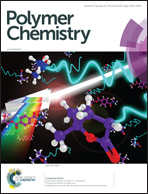Enhancement of microphase ordering and mechanical properties of supramolecular hydrogen-bonded polyurethane networks†
Abstract
The improvement of the mechanical properties of supramolecular polymer networks is currently receiving significant interest both within academic and industrial circles in order to enable the application of these desirable stimuli-responsive materials in real world situations. In this study, structural units within phase separated supramolecular polyurethane (SPU) networks have been changed to assess the role of the hard segment composition on the mechanical characteristics of the resultant materials. Notably, increasing the degrees of conformational freedom within the hard segment component of a SPU was found to improve the phase separation and as a consequence also increase the storage modulus of the polymer network. Specifically, replacing 4,4′-methylene diphenyl diisocyanate with 4,4′-dibenzyl diisocyanate within a SPU improved the packing efficiency of the isocyanate derived hard segments and improved the physical properties of the supramolecular polymer network. This study utilised a combination of SAXS, WAXS and AFM analysis to assess the degree of crystallinity within the hard segment component of the polymer network whilst rheological analysis was used to establish the mechanical characteristics of the polymers.



 Please wait while we load your content...
Please wait while we load your content...